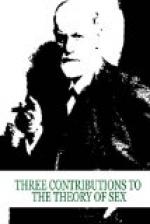The above-mentioned judgment concerning the literature of infantile sexuality no longer holds true since the appearance of the great and important work of G. Stanley Hall (Adolescence, Its Psychology and its Relation to Physiology, Anthropology, Sociology, Sex, Crime, Religion, and Education, 2 vols., New York, 1908). The recent book of A. Moll, Das Sexualleben des Kindes, Berlin, 1909, offers no occasion for such a modification. See, on the other hand, Bleuler, Sexuelle abnormitaeten der Kinder (Jahrbuch der Schweizerischen Gesellschaft fuer Schulgesundheitspflege, IX, 1908). A book by Mrs. Dr. H.v. Hug-Hellmuth, Aus dem Seelenleben des Kindes (1913), has taken full account of the neglected sexual factors. [Translated in Monograph Series.]
[3] I have attempted to solve the problems presented by the earliest infantile recollections in a paper, “Ueber Deckerinnerungen” (Monatsschrift fuer Psychiatrie und Neurologie, VI, 1899). Cf. also The Psychopathology of Everyday Life, The Macmillan Co., New York, and Unwin, London.
[4] One cannot understand the mechanism of repression when one takes into consideration only one of the two cooperating processes. As a comparison one may think of the way the tourist is despatched to the top of the great pyramid of Gizeh; he is pushed from one side and pulled from the other.
[5] The use of the latter material is justified by the fact that the years of childhood of those who are later neurotics need not necessarily differ from those who are later normal except in intensity and distinctness.
[6] An anatomic analogy to the behavior of the infantile sexual function formulated by me is perhaps given by Bayer (Deutsches Archiv fuer klinische Medizin, Bd. 73) who claims that the internal genitals (uterus) are regularly larger in newborn than in older children. However, Halban’s conception, that after birth there is also an involution of the other parts of the sexual apparatus, has not been verified. According to Halban (Zeitschrift fuer Geburtshilfe u. Gynaekologie, LIII, 1904) this process of involution ends after a few weeks of extra-uterine life.




